 Last Updated February 9, 2025
Last Updated February 9, 2025
The most common Vitamix shopper’s question is some variant of, “I want to make smoothies, soups, and frozen desserts. Which Vitamix blender is best for me?” The answer is that all Vitamix machines work great for those tasks; which one is best depends on the volumes you want to blend and whether you want to pay for extra features.
If you don’t want to go through the nitty-gritty, here are my quick Vitamix recommendations:
Which is the best Vitamix model?
Best Value
- E310 (short/narrow container for small to medium amounts)
- Recon 5200 (tall/narrow container for small to large amounts)
- Recon E320 (short/wide container for medium to large amounts)
Money Is No Object
- Ascent X5 (latest and greatest)
The February 2025 shopping landscape
Most Vitamix models are on sale through Feb 22nd for the President’s Day Sale. Here is the sale.
Vitamix recently released a new set of Ascent models. Full details are in my Vitamix Ascent X Series Review.
The Food Processor Attachment gives more reason to consider Ascent and Venturist models, since it is not compatible with classic models. If you don’t care about the premium finish of the A3500, consider saving big on the Reconditioned Venturist.
If you are looking for the lowest possible price, I recommend choosing between the Recon 5200, the E310, and the Recon E320. The most significant difference between these models is the container they come with, so use the following Venn diagram to pick the optimal container for you. There are trade-offs between the three container options. To put it briefly, “short, narrow, or large capacity: pick 2”: 
Note to visitors from outside the United States: The model availability described on this page is for the USA (and APO/FPO addresses). If you are shopping from Canada, check out my page about Canadian Vitamix models.
For most people, I recommend choosing from the following four categories: Certified Reconditioned models, Explorian, Premium Classic, and Ascent.
Reconditioned
 If you are looking for the lowest possible price on Vitamix, reconditioned is for you. Some people are hesitant to buy reconditioned, and that is a valid concern with some companies, but Vitamix’s reconditioned units are guaranteed to be top quality. The only reasons I would avoid reconditioned Vitamix are if it is for a gift for someone who won’t understand, or if you want some of the features not available on reconditioned machines.
If you are looking for the lowest possible price on Vitamix, reconditioned is for you. Some people are hesitant to buy reconditioned, and that is a valid concern with some companies, but Vitamix’s reconditioned units are guaranteed to be top quality. The only reasons I would avoid reconditioned Vitamix are if it is for a gift for someone who won’t understand, or if you want some of the features not available on reconditioned machines.
Explorian
 If you prefer a slightly smaller container, I highly recommend the new E310, which comes with a short and narrow 48-oz container (full review). The Explorian E320 is functionally identical to the E310, but it comes with a wide container. That makes it nearly identical to the 5300. (The E320 replaces the 5300 in the model lineup, and it is mostly the same, with a few changes: it does not have the on-off switch on the side, and it does not light up when on. I don’t think these differences matter much, but there they are for anyone wondering about E320 vs. 5300.)
If you prefer a slightly smaller container, I highly recommend the new E310, which comes with a short and narrow 48-oz container (full review). The Explorian E320 is functionally identical to the E310, but it comes with a wide container. That makes it nearly identical to the 5300. (The E320 replaces the 5300 in the model lineup, and it is mostly the same, with a few changes: it does not have the on-off switch on the side, and it does not light up when on. I don’t think these differences matter much, but there they are for anyone wondering about E320 vs. 5300.)
There is now also an Explorian E520, which comes with the wide 64-oz container and adds 3 preset blending modes. With the hidden discount that gets activated after clicking a Vitamix link on this site and then adding the Recon E520 to your shopping cart, it is an excellent deal.
Premium Classic and Propel
If you want the most premium machine, but don’t want the new technology of Ascent, then the Professional Series 750 is for you. I think the Ascent machines are quite nice, but you might not like the look of their digital display, or you might want to be able to use older containers (without NFC chips).
In 2023 Vitamix released a new Series, which they are calling the Propel. Similar to the Pro 750, these machines have preset modes and a secondary on-off switch. The Propel machines also have the subtly updated styling that was released with the Explorian series: Propel 510 and Propel 750.
Ascent (Smart System Blenders)
If you want to buy into the future of Vitamix, the Ascent Series is the way to go. It’s priced in the same range as new Legacy models, but it comes with various upgrades (among them: longer warranty, timer display, can use small cups without bulky adapter, and a wireless connection to smartphone app).

 Within the Ascent Series, the A2300 is the lowest-priced model and it has everything you need. (If you’re buying reconditioned, the A2500 is the lowest-priced model, and it has all the features of the A2300, including full variable speed control, and it adds 3 preset program modes.) If you feel like upgrading, I recommend going all the way up to the A3500, because it has premium finish options. (I’m not saying that the intermediate Ascent models are a bad choice, they just wouldn’t be my choice.) See my Ascent review page for more details.
Within the Ascent Series, the A2300 is the lowest-priced model and it has everything you need. (If you’re buying reconditioned, the A2500 is the lowest-priced model, and it has all the features of the A2300, including full variable speed control, and it adds 3 preset program modes.) If you feel like upgrading, I recommend going all the way up to the A3500, because it has premium finish options. (I’m not saying that the intermediate Ascent models are a bad choice, they just wouldn’t be my choice.) See my Ascent review page for more details.
If you’ve been putting off getting a Vitamix because you’re saving up, you can get one right away with a payment plan. If you make on-time payments, there are zero financing fees.
You can leave a comment below or contact me if you are still having trouble deciding which one to get.
Comparison of pre-Ascent models follows
If you want to quickly see the relation between all of the different Vitamix models, you can jump ahead to my comparison chart.
I made an interactive tool to help explore the different features. Try playing with it to get a sense of which you are interested in. You can click any model to go to its Vitamix.com page, or you can read more about the different models below.
+ Show model selection tool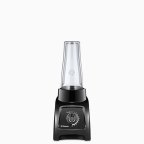 Recon S30
Recon S30  Recon 2-Speed
Recon 2-Speed  Recon 5200
Recon 5200  Recon 5300
Recon 5300  Recon Pro 500
Recon Pro 500 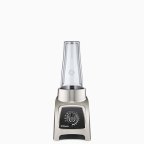 Recon S55
Recon S55  S30
S30  2-Speed
2-Speed 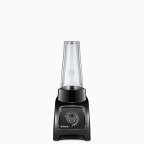 S50
S50  Recon 7500
Recon 7500  5200
5200  S55
S55 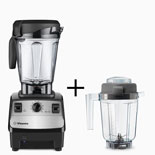 Recon 5300 + 32oz
Recon 5300 + 32oz  Recon Pro 750
Recon Pro 750  7500
7500  Pro 500
Pro 500  Recon 7500 + 32oz
Recon 7500 + 32oz  Pro 750
Pro 750 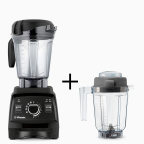 Recon Pro750+32oz
Recon Pro750+32oz  7500 + 32oz
7500 + 32oz  Pro 750 + 32oz
Pro 750 + 32oz  780
780 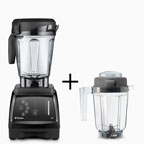 780 + 32oz
780 + 32oz(If you want the 32-oz container, you have to add it to your cart separately: 32-oz container link)
If you’re overwhelmed by the choices and just want to know my preference, I’ve used all of the different types of Vitamix blenders, and before I started using Ascent, the one I used on a daily basis was the 7500, with an extra 32-oz container for blending smaller amounts. (For the best deal, check out certified reconditioned.) All of the models are excellent, and I don’t think there is a wrong choice. (Plus, if you change your mind in the first 30 days, you can get a full refund, including free shipping both ways.)
Summary of Differences
These are the five key decisions to make when deciding which Vitamix to buy:
The following comparison chart shows the relations between the different machines in the S-Series, C-Series, and G-Series. The machines within most boxes of the chart are identical, but they come with different accessories and cookbooks (the exceptions are the S50 and S55, where the S55 has 2 more presets than the S50, and the Pro 750 and Vitamix 780, where the 780 has a flat touchpanel control). Generally the differences in accessories/cookbooks are pretty marginal, so I’d recommend going for the lowest price model within the box.

(“+” indicates there are also more expensive options in addition to the price listed in the chart. The following machines are not shown because they do not fit in with the rest: the Vitamix Turboblend Two Speed and Three Speed lack variable speed control, and the Vitamix 5300 and 6500 are a hybrid of the 6300 and 7500—i.e. they have a 7500 container on a 6300 base, without or with presets.)
Personal Blender? (S-Series vs. C-Series and G-Series)
(Vitamix S30 and S55 vs. 5200, 7500, et al.)
 In 2014 Vitamix released the Vitamix S30. It is smaller than the other Vitamix models, and also comes with a combination blending container/to-go smoothie cup. The Vitamix S50 and Vitamix S55 came out in 2015, and they are the same as the S30 but add preset modes. Since these models are significantly different from all the other models, I put up a detailed Vitamix S30 and S-Series review. If you are considering a smaller blender, or like the idea of blending in a to-go smoothie cup, you should check them out. Not surprisingly, the S-Series’ smaller size means that their maximum capacity is lower the other models (40 oz vs 64 oz).
In 2014 Vitamix released the Vitamix S30. It is smaller than the other Vitamix models, and also comes with a combination blending container/to-go smoothie cup. The Vitamix S50 and Vitamix S55 came out in 2015, and they are the same as the S30 but add preset modes. Since these models are significantly different from all the other models, I put up a detailed Vitamix S30 and S-Series review. If you are considering a smaller blender, or like the idea of blending in a to-go smoothie cup, you should check them out. Not surprisingly, the S-Series’ smaller size means that their maximum capacity is lower the other models (40 oz vs 64 oz).
Variable Speed?
(Vitamix Two Speed vs. 5200 and Vitamix 6000 vs. 6300)
 The variable speed control found on all Vitamix machines except for the Two Speed and 6000 is useful for when you don’t want to fully liquefy your blend. Examples are pesto, salsa, or chopping vegetables. If you don’t have variable speed, you can get away with quickly pulsing, but you won’t have quite as much control. The variable speed also makes the “bubble removal trick” more effective, although pulsing on low speed also works.
The variable speed control found on all Vitamix machines except for the Two Speed and 6000 is useful for when you don’t want to fully liquefy your blend. Examples are pesto, salsa, or chopping vegetables. If you don’t have variable speed, you can get away with quickly pulsing, but you won’t have quite as much control. The variable speed also makes the “bubble removal trick” more effective, although pulsing on low speed also works.
Preset Programs?
(Vitamix Two Speed vs. 6000, Vitamix 5200 vs. 6300, Vitamix Professional Series 200 vs. Professional Series 500, Vitamix S30 vs. S55, and Vitamix Professional Series 300 vs. Professional Series 750)
 The preset programs on the 6000, 6300/Pro 500, S55, and Pro 750 allow you to select a program, turn it on, and then the machine will automatically ramp up the speed and then shut off after a certain amount of time. There are a number of reasons that people appreciate this function:
The preset programs on the 6000, 6300/Pro 500, S55, and Pro 750 allow you to select a program, turn it on, and then the machine will automatically ramp up the speed and then shut off after a certain amount of time. There are a number of reasons that people appreciate this function:
• You can start the machine and “walk away” to do something else.
• If you strictly follow recipes the presets can yield more consistent results.
• Presets can give new users more confidence with the machine.
However, the presets do not work perfectly every time. Sometimes ingredients require tamping to start circulating past the blades, so you can’t always “walk away.” Also, the preset time might not be the optimum blending time if you modify a recipe. You may find that your smoothie is not fully blended after the smoothie program runs, so you have to run it again. A commercial coffee or smoothie shop makes the same recipes over and over, so in that setting presets are extremely useful. If you constantly make new combinations and of differing amounts, as many home users do, the settings may be less useful. It’s not too hard to tell when something is sufficiently blended, and after a few trials anyone should be able to figure it out. For these reasons, I personally would not pay extra for the preset settings. However, I know many people who have the presets love them. One thing to remember is that the machines with presets still have the variable speed knob for full manual control. If you don’t mind the added cost of presets, you can always switch back and forth to manual control.
C-Series vs. G-Series (Next Generation)?
(Vitamix 5200 vs. 7500, and Vitamix Professional Series 500 vs. Professional Series 750)
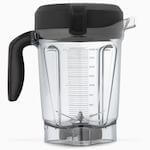 Vitamix released the “Next Generation,” aka “G-Series,” models in 2012. Both the base and the pitcher have an updated design. The base has slightly better sound muffling and also has better airflow which means that it can work harder before it overheats. To go with the better-cooled motor, the updated pitcher has a 4-inch blade instead of the Standard/Classic “C-Series” 3-inch blade. The 4-inch blade is in a shorter and wider container that has the same capacity as the 64-oz C-Series container.
Vitamix released the “Next Generation,” aka “G-Series,” models in 2012. Both the base and the pitcher have an updated design. The base has slightly better sound muffling and also has better airflow which means that it can work harder before it overheats. To go with the better-cooled motor, the updated pitcher has a 4-inch blade instead of the Standard/Classic “C-Series” 3-inch blade. The 4-inch blade is in a shorter and wider container that has the same capacity as the 64-oz C-Series container.
Advantages of the wider design:
• less need for the tamper (ingredients fall into the blades more easily)
• better chopping capability (you can course-chop more ingredients at a time)
• easier to scrape thick mixtures out
Advantage of shorter design:
• easier storage (at 17.5” tall, the container with lid on the base fits under standard kitchen cabinets)
Advantages of the 4-inch blade:
• faster processing time
• under some circumstances, marginally smoother blends
The one disadvantage of the new container is that for small volumes of under ~2 cups it does not work quite as well as the C-Series narrow container. The G-Series wider design causes two things to happen. First, there is more splashing up onto the inside of the lid and upper walls of the container, which means you lose a small amount of your blend unless you carefully scrape off the lid and walls. Second, you need slightly more volume to cover the blades and get good circulation going. The minimum volume to blend depends on what you are blending, and also on how much effort you are willing to spend pushing ingredients back into the blades. For example, for best results, the narrow containers can make nut butter easily by starting with 3 cups of nuts, whereas the wider Next Generation containers do best with 4 cups of nuts. For easier, more liquidy, blends, you can go below 1 cup in either container, but Next Generation containers will splash around more.
This disadvantage is a non-issue if most of your blends are over 2 cups, or if you are willing to spend a bit more to buy an additional narrow container, which will give you the best of both worlds. I like the 32-oz container for this purpose, although the 48-oz container has the same narrow bottom so it works just as well. The 48-oz container is just a bit bulkier on the outside because it sits outside the centering posts instead of inside of them, and its top is wider as well.
(The narrow C-Series Vitamix containers are compatible with G-Series models, but the G-Series containers are not recommended for use on C-Series models. The longer G-Series blades increase the load, and Vitamix does not recommend the C-Series cooling system for those increased loads.)
Reconditioned?
 Buying reconditioned is a great way to save money. For more details on deciding about buying reconditioned, see my refurbished Vitamix page.
Buying reconditioned is a great way to save money. For more details on deciding about buying reconditioned, see my refurbished Vitamix page.
Continue on for more details of each model type…
The array of different Vitamix blenders is a bit confusing, but it turns out that there is a lot of redundancy between the different models. I am only discussing models made for consumer/home use. Their commercial blenders are not ideal for home use because they are generally more expensive and have shorter warranties (3 years vs 7 years for home use; they are warrantied for constant use—think of how many times per day a blender at Jamba Juice runs compared to at your home).
The Vitamix website currently lists over 30 different home models, but they are all variants of three main designs: “personal” (S-Series), “standard/classic” (C-Series), and “next generation” (G-Series). For each of these main designs there are a few different options, to make a total of 8 different machine types. The rest of the models have identical bases, but come with different containers and/or accessories.
S-Series Motors
If the smaller size, dishwasher safe container, and “to-go” blending container appeal to you, please read the full details at my Vitamix S30, S50, and S55 review. For quick reference, the size of the base is 8.3″ deep x 5.9″ wide x 7.7″ tall. With the 20-oz to-go container the total height is 14.55″. The height is 15.66″ with the 40-oz container. These models have lower power, but they are still capable of making all of the usual Vitamix creations, just in smaller quantities.
C-Series Motors (Standard/Classic)
There are three types of bases of the standard variety. The differences are in the controls. The dimensions of the base of these machines are 8.75″ deep x 7.25″ wide x 8.25″ tall. There are three different container size options: 32 oz, 48 oz, and 64 oz, which result in height of base plus container/lid of 16.9″, 17.4″, and 20.5″ respectively.
Standard, no-variable speed (Vitamix TurboBlend Two Speed and Three Speed)
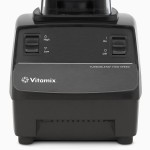 TurboBlend Two Speed (
TurboBlend Two Speed ($399$349); reconditioned for $299. This machine comes with a 5-year warranty and lacks the variable speed knob. Variable speed is useful for cases where you want to have finer control over the texture (i.e. if you don’t want a totally smooth purée). However, you can accomplish some non-liquefying chopping tasks by quickly pulsing the machine. While this is the most affordable new machine, I’d highly recommend looking at the reconditioned 5200, which has the same warranty and adds variable speed for $70 less.
In May 2016 Vitamix came out with a new no-variable speed machine, the TurboBlend Three Speed($499). It is exactly what it sounds like: it has three speed settings: low, medium, and high. It also has a pulse switch, which does the same thing as switching the start-stop button on and off. The pricing on this model is a bit strange, since for $50 less you can get a machine with fully variable speed. Plus, the TurboBlend 3-Speed comes with a 5-year warranty, instead of the 7 years on machines like the 5200.
Standard variable speed (Vitamix 5200 et al.)
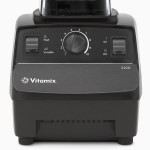 Until recently this was Vitamix’s bread and butter, and they have a lot of models to show for it: 5200 ($449), TurboBlend VS (retired), CIA Pro (retired), Pro 200 ($499), Creations II ($449), and Creations GC (retired); reconditioned for $329. These machines are essentially identical. Some are available with a shorter 48-oz container instead of the 64-oz container. The smaller container is nice because it’s more compact (and fits under standard kitchen cabinets), but of course its capacity is lower. The aesthetics of the switches and dial are slightly different between the different models. The Creations models come with a 5-year warranty, while the rest are 7 years. The 5200 comes with their “whole foods cookbook,” the TurboBlend VS comes with a vegetarian/vegan/raw cookbook and a nutmilk straining bag, the Pro models come with a cookbook with restaurant-oriented recipes (the CIA one—that’s Culinary Institute of America—comes with an additional recipe book). Note that if you buy reconditioned, you cannot choose which of the Standard models you are getting; Vitamix will choose for you based on availability, but remember that functionally they are identical.
Until recently this was Vitamix’s bread and butter, and they have a lot of models to show for it: 5200 ($449), TurboBlend VS (retired), CIA Pro (retired), Pro 200 ($499), Creations II ($449), and Creations GC (retired); reconditioned for $329. These machines are essentially identical. Some are available with a shorter 48-oz container instead of the 64-oz container. The smaller container is nice because it’s more compact (and fits under standard kitchen cabinets), but of course its capacity is lower. The aesthetics of the switches and dial are slightly different between the different models. The Creations models come with a 5-year warranty, while the rest are 7 years. The 5200 comes with their “whole foods cookbook,” the TurboBlend VS comes with a vegetarian/vegan/raw cookbook and a nutmilk straining bag, the Pro models come with a cookbook with restaurant-oriented recipes (the CIA one—that’s Culinary Institute of America—comes with an additional recipe book). Note that if you buy reconditioned, you cannot choose which of the Standard models you are getting; Vitamix will choose for you based on availability, but remember that functionally they are identical.
Sometimes these models are listed with their color-specific SKU. All of the following models are identical to the 5200, they just come with different colors and names: Vitamix 1709, 1363, 1364, 1365, 1709, 1723, 1732. They also sometimes go by VM0103. Vitamix 1978 is also the same, but comes with a 48-oz container.
Standard variable speed + presets (Vitamix 6300 and Professional Series 500)
 Pro 500 ($559) and 6300 (retired); reconditioned for $379. These are the same model; the only difference is that the 6300 comes with the “Savor” cookbook, which has a broader range of recipes than the Pro 500’s “Create” cookbook, which focuses more on restaurant-style recipes that tend to be richer.) They have 3 preset programs that run the blender for a certain amount of time and speed for smoothies, frozen desserts, and hot soups. Their switches are slightly different from the non-preset models. The non-preset models have an on-off switch, a variable speed knob, and a high-variable speed switch. The preset ones have moved the highest speed setting onto the knob and replaced the high-variable speed switch with a pulse switch. This is really a minor aesthetic difference, since you can achieve pulsing on the non-preset models by quickly flicking the on-off switch on and off.
Pro 500 ($559) and 6300 (retired); reconditioned for $379. These are the same model; the only difference is that the 6300 comes with the “Savor” cookbook, which has a broader range of recipes than the Pro 500’s “Create” cookbook, which focuses more on restaurant-style recipes that tend to be richer.) They have 3 preset programs that run the blender for a certain amount of time and speed for smoothies, frozen desserts, and hot soups. Their switches are slightly different from the non-preset models. The non-preset models have an on-off switch, a variable speed knob, and a high-variable speed switch. The preset ones have moved the highest speed setting onto the knob and replaced the high-variable speed switch with a pulse switch. This is really a minor aesthetic difference, since you can achieve pulsing on the non-preset models by quickly flicking the on-off switch on and off.
Some people love the presets because you can set it and walk away (assuming the mixture is circulating and you don’t need the tamper), and because they get more consistent results. However, the more consistent results will only hold if you always add the same quantities and types of items to the blender. For example, if you’re making a small smoothie, you can blend it for less time than if you were making a large one. One other thing is that you can set the non-preset machines and walk away—you just have to come back to stop them. I often use the blending time to rinse off the knife and cutting board that I used. You’re not likely to forget that the Vitamix is running because it’s loud enough to hear throughout the house. The variable speed knob goes to the same high speed as the previous models on high, but it’s lowest setting is a bit faster than on the 5200 et al., so you lose a tiny bit of fine control. Whether the presets are worth it is a personal question—I wouldn’t pay extra for them, but some people love them.
Standard no variable speed + presets (Vitamix 6000)
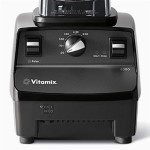 6000 (retired). Released October 2013, this is more of a mash-up of existing machines than a truly new one. It’s a sort of blend between the Two Speed, and the 6300. It does not have variable speed control, but it has six preset timed blending settings. These settings will automatically ramp up the speed, and then turn it off after a specified time of 20 sec, 30 sec, 1 min, 1.5 min, 4.5 min, or 6.5 min. Like the 6300, the pulse control is spring-loaded so that it only stays on as long as you hold it down, and it blends at a medium-low speed.
6000 (retired). Released October 2013, this is more of a mash-up of existing machines than a truly new one. It’s a sort of blend between the Two Speed, and the 6300. It does not have variable speed control, but it has six preset timed blending settings. These settings will automatically ramp up the speed, and then turn it off after a specified time of 20 sec, 30 sec, 1 min, 1.5 min, 4.5 min, or 6.5 min. Like the 6300, the pulse control is spring-loaded so that it only stays on as long as you hold it down, and it blends at a medium-low speed.
G-Series Motors (Next Generation)
In 2012 Vitamix released a new generation G-Series base with improved airflow that makes it run cooler and quieter than the classic C-Series one. With the improved cooling, the G-Series base can use a new pitcher design that is wider and has longer blades. This design makes the tamper less necessary, and makes it easier to get thick mixtures out. The longer blades also process food faster and work better for chopping. The G-Series machines are compatible with the C-Series containers, so if you want to use the dry blade you can use the same classic dry container. Dimensions are 9.4″ deep x 7.7″ wide x 17.5″ tall (with new-style 64-oz container in place). For more details of sizes, check out the PDF footprints I made for my Vitamix S30 review.
Next generation motor (Vitamix 7500, Professional Series 300, and Creations Elite)
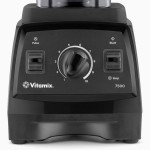 7500 ($529), Creations Elite ($557.50), and Pro 300 ($559); reconditioned for $439. These are all the same machine, so don’t worry about the note on the Reconditioned Next Gen page that says that the label may reflect any of these models. The only difference is the name printed on it. One point of confusion is that the Creations Elite is sold new with a smaller container, but if you happen to get sent a Creations Elite as a Reconditioned Next Gen, it will come with the same low profile 64-oz container that the 7500 comes with.
7500 ($529), Creations Elite ($557.50), and Pro 300 ($559); reconditioned for $439. These are all the same machine, so don’t worry about the note on the Reconditioned Next Gen page that says that the label may reflect any of these models. The only difference is the name printed on it. One point of confusion is that the Creations Elite is sold new with a smaller container, but if you happen to get sent a Creations Elite as a Reconditioned Next Gen, it will come with the same low profile 64-oz container that the 7500 comes with.
Next generation motor + presets (Vitamix Professional Series 750 and Vitamix 780)
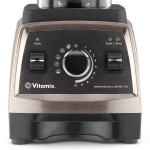
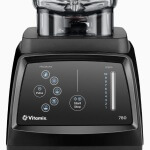 Pro 750 ($599–$649), 780 ($719); available reconditioned: 750 for
Pro 750 ($599–$649), 780 ($719); available reconditioned: 750 for $519–$569$499, and 780 for $519$399. These models have 5 presets: smoothies, frozen desserts, purées, hot soups, and self-washing. If you want to see more details of exactly what the presets do, check out my page about demystifying Vitamix presets. The 780 is identical, except that it has a touchpanel control interface. See my Vitamix 780 review for more details.
Vitamix Heritage 750 vs. Original 750?
In late 2015, Vitamix released a new version of the Pro 750: the Heritage line. The Vitamix Heritage 750 is functionally equivalent to the original Pro 750, but it has two differences on the exterior of the base. The upper shell (see diagram below) is now metal on the Heritage models. The Vitamix website doesn’t put Heritage in the model title, but it’s there in the description.
 The original 750 came in a brushed stainless finish option, but the upper shell was plastic with a thin metallic coat that could be scratched or scuffed. (When I tested the original 750 for a couple of months, I did not see any problems, but I have heard that some people have noticed scratches/scuffs.) The solid metal of the new Heritage models is more durable. Also, the metal shell muffles the the motor a bit more than the plastic, making the Heritage models a bit quieter.
The original 750 came in a brushed stainless finish option, but the upper shell was plastic with a thin metallic coat that could be scratched or scuffed. (When I tested the original 750 for a couple of months, I did not see any problems, but I have heard that some people have noticed scratches/scuffs.) The solid metal of the new Heritage models is more durable. Also, the metal shell muffles the the motor a bit more than the plastic, making the Heritage models a bit quieter.
 The other minor difference is that the Heritage models’ front panel has fewer backlights: Heritage models light up the indicators above the pulse and start-stop switches, whereas the original Pro 750 has backlights around the central knob as well.
The other minor difference is that the Heritage models’ front panel has fewer backlights: Heritage models light up the indicators above the pulse and start-stop switches, whereas the original Pro 750 has backlights around the central knob as well.
The Heritage metal is available in brushed stainless and copper finishes. (Currently on Vitamix.com, the Heritage options are listed on the main Pro 750 page, and the old brushed stainless finish is discontinued.)
I believe it is called Heritage because it is a throwback to the original Vitamix models that had all-metal bases. The plastic that Vitamix has been using for their bases for the past 25 years is extremely durable, so this change won’t affect functional longevity. That said, the elegant finish of the Heritage models will now likely stay unblemished for longer. It’s also nice that Vitamix did not increase the price for this upgrade.
The Vitamix 5300 and 6500
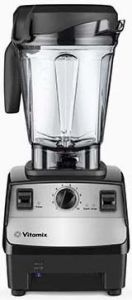 5300 ($529) and 6500 ($599); reconditioned for $360. Vitamix does not currently sell the new models online, only the reconditioned one. These are “new” models for 2015, although they are actually just slightly unexpected mash-ups of previous models. They are a hybrid between a 6300 and a 7500. They use the wide Next Gen (G-Series) container but they have a Classic (C-Series) base. The 5300 has variable speed and a pulse control switch, and has no presets. Meanwhile, the 6500 has the same three presets as the 6300. (Further evidence of equivalence between the 5300/6500 and C-Series models is on the Reconditioned C-Series 6300/Pro 500 page: it says its base may be a 6500.)
5300 ($529) and 6500 ($599); reconditioned for $360. Vitamix does not currently sell the new models online, only the reconditioned one. These are “new” models for 2015, although they are actually just slightly unexpected mash-ups of previous models. They are a hybrid between a 6300 and a 7500. They use the wide Next Gen (G-Series) container but they have a Classic (C-Series) base. The 5300 has variable speed and a pulse control switch, and has no presets. Meanwhile, the 6500 has the same three presets as the 6300. (Further evidence of equivalence between the 5300/6500 and C-Series models is on the Reconditioned C-Series 6300/Pro 500 page: it says its base may be a 6500.)
The reconditioned 5300 is the most affordable option for a machine with the short/wide container.
The strange thing about these models is that previously Vitamix stated that Next Gen containers should not be used on Classic bases because they do not have the updated airflow design that cools the motor more effectively.
I strongly suspect that the 5300 has the same microprocessor speed control as the 7500, Pro 750, and 6300, just without the presets. (You can read about the speed control of the different machines on my Vitamix RPM measurement page.) The microprocessor speed control should help protect the motor when using the wide container at high loads and very low speeds, but at maximum speed it shouldn’t make a difference. The marketing copy for the 5300 says that it comes “with a faster, yet quieter, motor,” but I am skeptical of those claims [Update: interestingly, Vitamix removed that phrase].
The 5300 and 6500 are a bit louder than the G-Series bases, which have sound-dampening technology not present in the C-Series bases. At the same price point, I would prefer the 7500.
Satisfaction Guarantee
Vitamix has a 30-day satisfaction guarantee, so if you have second thoughts you can return a machine within the first 30 days for a full refund and they even pay return shipping.
Warranty
If your machine has any problems during the warranty period of 5 or 7 years, Vitamix will repair or replace it, and they cover shipping costs both ways. For more details about warranties, check out my Vitamix Warranty page.
Reconditioned Vitamix
 I know I already mentioned reconditioned machines, but I want to restate what a great deal I think they are. These factory-refurbished machines offer the best prices you’ll find on Vitamix: 5200 for $329, Pro 500 for $379, and 7500 for $439. For more details, see my refurbished Vitamix page.
I know I already mentioned reconditioned machines, but I want to restate what a great deal I think they are. These factory-refurbished machines offer the best prices you’ll find on Vitamix: 5200 for $329, Pro 500 for $379, and 7500 for $439. For more details, see my refurbished Vitamix page.
Payment Plans
Want to start blending right away, but don’t want to pay the full price up front? Vitamix offers payment plans with zero interest and no fees if you make payments on time. For more information, check out my payment plan page.
Free Shipping
Clicking on any Vitamix link on this page will automatically apply a promotion code, which gives you free shipping on your order of a Vitamix machine (or anything else on Vitamix.com over $50) in the U.S. or Canada. For more details, see my page about the Vitamix promotion code.
Extra Bonus
If you order via a link on this site, Joy of Blending can get a commission. I deeply appreciate your support, and, to thank you, I want to help you get the most out of your new machine. I try to answer all questions from everyone, but sometimes I get swamped. If you order through one of my links, I will give you a private way to contact me so that I can answer your questions before visitors who are not on the special list. Please make sure my link is the last link you click before placing your Vitamix.com order. Then just forward your order confirmation to thanks@joyofblending.com.
Recommended Accessory
I highly recommend a spatula for getting the last bits of thick mixtures out of the container. For the narrow containers I recommend a long narrow spatula. For the wide containers, I recommend Vitamix’s under-blade scraper.
Dry Container
If you’re wondering if you should get a dry container, this new post is for you: Is the dry container worth it?
Phew… so that completes the Vitamix model round-up. I’m looking forward to getting back to describing some actual recipes!
Or follow along on Twitter or Facebook:

Such a helpful article. Personally, I think Vitamix makes it more confusing than it needs to be, especially since the end result is basically the same.
I was leaning toward the new S55 just because it is less intimidating. I like pre-sets (over the S30) and feel it would make a first-time user more comfortable with using the machine on a daily basis.
Then I had second thoughts; I read reviews, watched videos, etc. I was wondering to myself if I would be making a mistake not getting a full-sized model, despite the fact that I don’t think my needs require the full-size.
Anyway, for another 100-plus-something-dollars, I’ve decided to get the Pro 750 (stainless) reconditioned. It’s a lot of money any way you look at it, but I feel the G-Series (vs. S-Series) will be a better investment, especially if I end up discovering that I use it more than planned.
Anyway, I’m looking forward to taking the plunge. It’s been a long time coming. And thank you again for such an informative breakdown.
I’ve been wanting a Vitamix for a number of years now, but can’t decide on the model. When it comes to kitchen appliances I probably overbuy in most situations. I was looking to get a refurb 5200 until I saw the new Next Gen models. I also just saw the newest 5300 model at Costco. Which would you suggest? Your comments on the 5300 leave me a little skeptical but it looks like it has all the same motor specs as the Next Gen for less cost. Any help would be appreciated.
Glenn
Hi Glenn,
The 5300 is a bit different from the Next Gen models. The base of the Next Gen models is a different shape, which aside from looking slightly sleeker, does two things. 1) It allows more air to cool the motor, which means it is less likely to overheat, and may extend motor life. 2) It has better sound damping, which makes the machine a bit quieter. So if you want the better machine, I say go for the Next Gen.
On the other hand, if you want to save some cash, the Standard reconditioned is currently on sale, making it an even better deal than it usually is. If it were me buying right now, I would probably go with the Standard reconditioned unless the taller container was an absolute deal-breaker. (And even if the tall container is an issue, you may want to consider a secondary small 32-oz container to go with either a Standard or Next Gen — I love the 32-oz container for daily use making recipes for 1-2 people. You can keep a 32-oz container on the machine, which will make it slightly shorter than a Next Gen with the wide 64-oz container, and then keep the 64-oz container packed away to bring out when you want to make bigger recipes.)
This info is only useful so much as you already know all the main things about vitamixes. It kept talking about c series, g series, etc., but never said exactly which models fall in each category. So I had to leave this site and Google other info to figure it out.
Thanks for sharing the constructive criticism. It’s a lot of information and I know it can be confusing.
Did you see the chart towards the beginning under the heading “Summary of Differences?” I believe that explains “which models fall in each category,” but if it was unclear to you, I’d like to know.
Did the chart not display for you? Or did you not notice the chart? I could look into making more references to it, because it is central to understanding the differences and similarities between models.
Where I am still confused is the CIA Professional Series falls into which of the three categories of Vitamix you have listed? The Vitamix website is not even able to give me information about all of the blenders made in the CIA Professional Series? For ex, the CIA Professional series all have numbers before them like 1363 etc….I’m trying to find side by side comparisons of all the CIA Professional series….side by side of all the specific models under each of the other three series listed above and on the vitamin website.
The CIA Professional Series is a variable speed, C-Series model, functionally identical to the 5200. (It’s listed as CIA Pro in my chart with all the models.) The different numbers for the CIA Pro refer to different color options for the base.
I have a few questions, not comment.
1. Does Vitamix 7500 have same horsepower as Vitamix 750?
2. Is the container made out of glass (breakable)?
3. Is the container light?
4. Does Vitamix 7500 or 750 make lot of noise when blend?
1) Yes, the Vitamix 7500 has the same HP as the Pro 750. (The only difference is the presets on the Pro 750.)
2) The container is not made of glass. It is Tritan copolyester, which is essentially shatter-proof.
3) The container is not exactly light. It weighs 2 lb 10 oz or 1190 g.
4) The Vitamix 7500 and Pro 750 make a fair amount of noise. Less noise than many other blenders, but still loud enough that I prefer to wear ear protection.
Thank you so much for prompt response as well as detailed response.
I am 60-yr old and my wrists aren’t strong enough to lift up and down the container. It would be nice if the containers are made lighter for weak wrist people and elderly people.
Thank you very much again.
Sincerely,
Jeannie
Here’s a further clarification since the weight is a concern to you. The weight I listed previously is of the container with lid and lid cap in place. You could remove the lid before lifting it, which would bring it down to just under 2 lbs, or 900 g.
The smaller containers are also a bit lighter. You can get a 32-oz container, which is just under 2 lbs with the lid, and 1 lb 8 oz (675 g) without the lid.
Thank you for kind info. I will consider the 32 oz container.
Thank you again for all your feedback.
It’s been nice of you in giving me informative info.
May your business be prosporous and wish healthful life for you and your family.
Thanx! Very helpful.
can you process more ingredients in the tall container vs the smaller same volume container because of the splashing?
I’m assuming you’re talking about the tall 64-oz C-Series container and the shorter (and wider) 64-oz G-Series container. The short answer is that the maximum amount to process is the same in those two containers. They’re both rated for 64 oz, and you can blend the full 64-oz capacity in them. Their lids prevent splashing from being a problem. The lids are dome-shaped, going above the top of the container, which allows you to have pre-blended ingredients that go above the 64-oz line. It’s not recommended, but I have successfully blended up to ~72 oz of blended liquid in the tall 64-oz container. I have not yet tried going over the 64-oz capacity of the shorter/wider G-Series container, so I’m not sure if it would stay sealed as well as the tall container (the lid seal is slightly different).
I am choosing between the 5200, Pro 750 and Prof 300. I have a high priced juicer but it literally takes every fiber of fruits and veggies & pulp out and leaves pure liquid. I like the smoothie consistency and I wonder which is best for that type of blending. I don’t think I will use it a lot as the juicer went under the cabinet after about 4 uses as I didn’t like the end result. I want a new one and am using credit card points to buy it so which would you choose? I hope to use it more and more over time…
All Vitamix models will give you a great smooth consistency. If you want to pull out all the stops, go for the Pro 750 with an extra 32-oz container. Otherwise, the question is whether you want to pay extra for presets and the G-Series container. To help you decide, you can read the sections on presets and G-Series models above.
Thank you for the detailed information. I had no idea there were so many different Vitamix models to choose from. So my dilema… I am now really confused. I am looking for the model that makes the hot soup, smoothies and ice cream. I don’t want to spend over $450. Which one do you recommend?
All Vitamix models can make the things you listed, so that does not really narrow it down. At your price point I would recommend a reconditioned 7500, unless you anticipate frequently blending volumes under 2 cups, in which case a Classic machine with a narrow container would be preferable. (I like having a 7500 plus a narrow 32-oz container, but that will run over $450.) I’d say go with a 5200, reconditioned if you want to save some cash.
the promo code u mention for free shipping doesn’t seem to be calculating it when i attempt to order online. Should i call instead?
nevermind, my mistake, i got the promo code for free shipping to work. Thanks for a great blog.
Oh, good. I just checked it, and it’s working.
Hi,
thank you for all the work you do to help people like me! We already purchased the 5300 since it had the smaller container and the dial and found a great price.
I saw on vitamix website comments that the label on the base 2.3 hp and the manual lists 2.1 peak hp and on web 2.2hp.In your opnion Which label is mostly the true indicator and why are these vitamix printed specs all different for the same machine?
The other question is the pulse feature on the machines the same as the ‘high and variable” switch in the same area on other vitamix models?
Finally, from your amazing analysis, is the concern of the 5300 that because it probably has the newer motor with the microsensor (like the gseries models) but has the base of c series, the motor might not last the typical length because of the cooling design..is that the only difference?
I am worried we bought a vitamix model that might have long term problems…would Vitamix release a model that is confusing in specs and in their message of new jars on their c series bases but yet they sell a whole model with exactly that? What should we do?
THANK YOU
Vitamix has made this confusing. I’ll do my best to answer your questions.
Vitamix (like most other consumer appliance manufacturers) does not explicitly state their definition of peak horsepower. It’s a bit nebulous, and not particularly meaningful.
I am skeptical about Vitamix’s labeling of different peak HP ratings on their different home models because of some measurements that I have made. At a variety of loads, the a C-Series 5200 and a G-Series 7500, which Vitamix rates at 2 and 2.2 peak HP respectively, delivered identical power (at least to within a few percent—well under the 10% stated difference). So, while I haven’t tested a 5300 yet, I would be surprised if it has different power from both the C- and G-Series models.
The pulse switch is in the same place as the high-variable switch on other models, but it serves a different function. The pulse switch is like the on-off switch, except it only stays on as long as you hold it, whereas the on-off switch will stay on without you holding it. For models with a pulse switch, speed 10 is more or less equal to “High” on models with the high-variable switch. (It’s slightly more complicated than that, if you want to get into the subtleties, you can check out my speed measurement post.)
The concern about the longevity of the 5300 is that it draws a higher load than C-Series models because it has the 4-inch blade, but it does not have the updated airflow design of the G-Series. How much of an issue this is remains to be seen. So, what should you do? Your machine is probably fine. Swapping it for a 7500 may give you a motor that lasts longer, and the 7500 also has the updated sound-dampening design.
Just FYI about the 5300:
On the Vitamix site, it shows the 5300 motor is 2.2 HP (same as 7500), and the 5200 with 2 HP max. While the 5300 says it has 3-inch blades, it lists the 64-oz wide container, and they only make one with 4-inch blades.
Conclusion: the 5300 definitely has same power motor as 7500 and uses same 4-inch blade 64-oz wide container as the 7500.
Both the 5300 and 7500 are the same price on their site, so it’s definitely an odd duck. Since the price is identical, you’d think they’d discontinue the 5300.
I just wrote a discussion of the HP issue in a response to the comment directly above yours (I wrote it after you commented, so no worries).
You are correct that Vitamix.com has some of the specs wrong. The 5300 does indeed come with 4-inch blades. (Another page that has a similar, but opposite mistake is the Vitamix.com page for the Creations Elite, which says that it comes with 4″ blades, when it actually comes with 3″ blades.)
Is there any difference between the Vitamix’s sold at Costco vs. elsewhere? As in quality of parts, etc.?
Same quality from the same factory. Although of course different models have different features, and also the Costco models often come with fewer accessories (e.g. no DVD and much shorter cookbook on the 5200S and 5300S…).
Is there a disadvantage of the shorter, wider 64 oz container that now come with the 6500 vs. the taller 64 oz. that come with the 6300? It seems nut butter will be better but would smoothies (in smaller quantities) not work as well with a wider base? Thanks for your helpful and informative blog post!
You are right that smaller quantities (under ~2 cups) in the wider container do not work as well as in the narrow container. For that reason, I use a 32-oz container on my 7500 when I want to blend small amounts. You can read my full thoughts on the subject above in the C-Series vs. G-Series section.
Questions: I need a vitamix that will cream veggies fruits into smoothies, cook veggie cream soups and make almond butter ice cream. I also prefer one that is quiet, and long lasting as this is a dedicated blender for my child with 23 food allergies and has swallowing texture issues…(i.e. i blend a lot but nothing is blending creamy enough), hoping to also add a safe homemade ice-cream to her diet with this blender,…suggestions of models etc are appreciated. Im overwhelmed on the vmix website.
From what you said, I would recommend any C- or G-Series model. That still leaves a lot of options. If you want a quick recommendation, I’d say go for a 5200 or a 7500. If you get a 7500, consider getting a spare 32-oz container for blending small amounts, since the 7500 has a wider container that is non-ideal for blending volumes under ~2 cups. (7500 + 32-oz container is what I use daily.) If you want more details, pretty much everything I have to say on the subject is up in the buying decisions sections at the top of this page.
Which Vitamix works best for grinding various kinds of grains to make flour?
Any C- or G-Series model plus the dry grains container will work best for making flour.
I am looking to purchase 4- 7500 Vita Mix blenders as gifts. Refurbished (with 32 ounce containers as well) Any chance I can receive a discount for purchasing 4?
Last I heard, you can get a 5% discount if you buy more than one machine at once. To get the discount, you must place your order by phone. Lately their phone lines have been pretty busy, so to minimize wait time, I recommend calling as early in the morning as possible. They open at 8am EST weekdays, and 9am EST Saturdays. Their phone number is 800-848-2649. And don’t forget to mention code 06-007021 for free shipping.
Would you mind giving your subjective opinion on the noise difference between the 5200 and 7500? I’ve seen a lot of people mention that the difference is very small.
Are they being misleading when they say 40% quieter? How much would you personally pay more for the 7500 if the only difference you cared about was sound? $25? $50?
Noise levels are hard to properly quantify. In addition to depending on which frequencies you are sensitive to, the environment around the blender can also make a big difference in terms of what happens to the sound.
In my experience the difference in sound between the 5200 and 7500 is indeed minor. But the small difference is offset by the fact that these machines last so long, and you will probably use it many thousands of times…. Hard to say what value I would put on the sound. I find all blenders to be loud, so I prefer to wear earmuffs when blending (or vacuuming, or weedwhacking….). With the earmuffs, the sound difference between different models is not significant, so, I guess, personally, if price were a significant concern then I would not pay much extra for the sound damping. Of course there are other differences between those machines, the biggest of which is the shorter/wider container on the 7500, which I detailed in the main post above. The 7500 also has the newer airflow design (which should better resist overheating and help the motor last even longer), a secondary on-off switch, a pulse switch, and fancier styling.
Hello Adam,
I have a question – I noticed that there is NO TURBO mode available on the new series models (like PRO 750) in comparison with for example 7200 model.
7200 – the left switch is for turbo mode (high revolutions)
PRO 750 – the left switch is for pulse mode (it seems a bit needless to me)
Do you know why is that, please?
Great site man, I love your content.
Thanks for the quality stuff and sharing the knowledge.
Jan,
Czech republic
On G-Series machines (like the Pro 750), Vitamix moved the top speed from the left switch to speed 10 on the dial. My guess is that they did this to simplify operation—you just dial up the knob instead of dialing up the knob and then flipping up the left switch. The pulse switch can be handy, although it is indeed a bit redundant with the start-stop switch, since you can can achieve pulsing on the 5200 by just flipping the on-off switch up and down. (I’m assuming you meant 5200 not 7200, since I do not know of a Vitamix 7200.)
Hello Adam,
thank you for your swift answer, I indeed appreciate it. It is clear to me now and I am very happy that my already-beloved Pro 750 is as strong as any other model… And yes, you are correct – I meant 5200.
Thanks man! 🙂